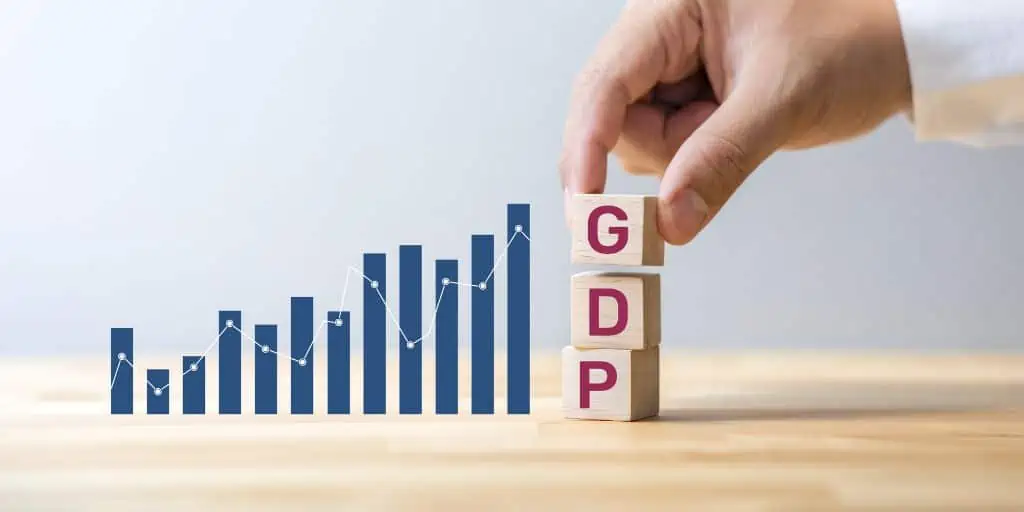What Is Gross Domestic Product (GDP)?
REtipster does not provide tax, investment, or financial advice. Always seek the help of a licensed financial professional before taking action.
Shortcuts
- Gross domestic product or GDP is an economic metric that measures the total value of all products and services produced in a country.
- Policy-makers in government and business use GDP to make economic, fiscal, and political decisions.
- There are several ways to calculate GDP, but it’s often a sum of a country’s consumption, investment, government spending, and net exports minus imports.
- While useful, GDP doesn’t account for intangible factors in an economy and society, so it shouldn’t be the sole metric to measure a country’s prosperity.
What Does GDP Measure?
GDP measures the sum value of all products and services produced by individuals, businesses, and governments within a country in a given period, either quarterly or annually. These goods and services include everything from food and clothing to education and healthcare.
GDP is calculated by adding up the value of all these goods and services minus the value of any imported goods and services.
While this figure is a useful measure of a country’s economic performance and guides policy-makers in crafting economic, fiscal, and political decisions, it has some notable limitations. For example, GDP doesn’t account for intangible factors like income inequality, environmental degradation, and unpaid work[1]. Therefore, it shouldn’t be the sole measure of a country’s overall well-being.
Nonetheless, GDP remains an important tool for understanding the general health of an economy.
Simon Kuznets and GDP
Simon Kuznets, an American economist, proposed the idea of a gross domestic product in the 1930s[2]. This resulted from a U.S. Congress commission to develop a measure of national income. They had hoped to use this metric to help guide policy-making during the Great Depression.
In 1934, he presented the “national income and product accounts,” which included estimates of both national income and output. Kuznets refined this concept over the years, eventually becoming the standard measure of a country’s economic output or GDP.
However, Kuznets also warned that GDP should not be used as the only measure of economic performance or well-being. In fact, Kuznets himself emphasized the limitations of GDP as a measure of economic growth and social progress. For example, he recognized that GDP does not consider important factors such as income distribution, environmental degradation, and the value of non-market activities such as household work and volunteering.
In his 1934 report to Congress, Kuznets wrote[3]:
“The welfare of a nation can scarcely be inferred from a measure of national income… Goals for ‘more’ growth should specify more growth of what and for what…”
Kuznets believed that GDP is a vital tool for measuring economic activity, but it should be used in conjunction with other measures to provide a more comprehensive picture of a country’s progress.
For his pioneering work on national income accounting, Kuznets received the Nobel Prize in Economics in 1971[4].
What Is GDP Used For?
GDP is used to assess a country’s economic growth and development. Moreover, many policymakers, investors, and businesses make important economic and political decisions using their country’s GDP.
One of its primary uses is to measure the size and growth rate of a country’s economy over time. It is often used to compare different countries’ economic performance and track changes in economic activity within a single country. Policymakers may use GDP data to gauge whether a country is in a recession or a period of economic expansion[5].
Another use of GDP is to serve as an indicator of a country’s standard of living. While it is not a direct measure of people’s well-being, higher GDP per capita generally means that people have more resources to spend on goods and services, which can contribute to a higher quality of life.
However, as Simon Kuznets himself pointed out, other factors can affect social prosperity and satisfaction, such as income distribution, social services, and environmental factors[6].
Governments also use GDP figures to reach policy decisions related to economic growth, employment, and fiscal policy. For example, governments may use GDP data to identify which sectors of the economy are growing or declining and to target policies that could promote growth in specific areas. Using GDP, they can evaluate the effectiveness of policy interventions, such as stimulus programs or tax cuts.
Meanwhile, businesses can refer to GDP as a benchmark for making strategic decisions. For instance, companies may use GDP data to identify which countries or regions are experiencing high economic growth levels and target their marketing and sales efforts accordingly.
How to Calculate GDP
To calculate GDP, you generally find the sum of a country’s consumption, investment, government spending, and net exports minus imports.
In formula form, it looks like this:
GDP = C + I + G + (X – M)
Where:
- C represents consumption, which includes all the goods and services purchased by households;
- I represents investment, which includes all the goods and services purchased by businesses to produce more goods and services in the future;
- G represents government spending, which includes all the goods and services purchased by the government for public use or investment;
- X represents exports, which are the goods and services produced within a country and sold to other countries;
- M represents imports, which are the goods and services produced in other countries and purchased by domestic consumers, businesses, or the government.
There are also other approaches to calculating GDP, as explained below.
Other Ways to Calculate GDP
- Expenditure Approach: This method adds the total spending on final goods and services in an economy over a given period[7]. This is the most commonly used method, exemplified by the formula above.
- Income Approach: This approach adds up the total income earned by all factors of production in an economy over a given timeframe[8]. This formula includes various components, such as wages and salaries, rental income, interest income, and profits. Governments may use the income approach to calculate GDP by adding up the total income earned by workers, business owners, and investors in the economy.
- Production Approach: This system totals the value added at each stage of production in an economy over time[9]. Policymakers may use the production approach to calculate GDP by adding the value added by agricultural, manufacturing, and services industries and subtracting the value of intermediate goods and services used in production.
Variations in GDP can be seen across different countries and times due to various factors such as economic policies, natural resources, technological innovation, and political stability. As a result, GDP can vary widely across countries and time periods depending on these elements.
Additionally, GDP may fluctuate over time due to changes in economic conditions such as recessions, booms, and natural disasters.
The Drawbacks of GDP
Despite its widespread use, GDP has limitations as a measure of economic performance.
One of the main criticisms of GDP is that it does not account for income distribution, environmental degradation, and non-market activities such as unpaid work. Additionally, GDP may not capture the value of new technologies, cultural production, or other intangible factors contributing to economic growth and well-being.
As a result of these limitations, there has been increasing interest in developing alternative measures of economic progress that account for a broader range of social and environmental factors. Some examples of alternative measures include the Human Development Index (HDI), the Genuine Progress Indicator (GPI), and the Ecological Footprint[10].
These measures attempt to capture a more comprehensive picture of economic progress beyond GDP.
Sources
- How well GDP measures the well-being of society. (n.d.) Khan Academy. Retrieved from https://www.khanacademy.org/economics-finance-domain/macroeconomics/macro-economic-indicators-and-the-business-cycle/macro-limitations-of-gdp/a/how-well-gdp-measures-the-well-being-of-society-cnx
- Dickinson, E. (2011, January 3.) GDP: a brief history. Foreign Policy. Retrieved from https://foreignpolicy.com/2011/01/03/gdp-a-brief-history/
- Boushey, H. (2019, October 28.) The Way We Measure the Economy Obscures What Is Really Going On. The New York Times. https://www.nytimes.com/2019/10/28/opinion/economic-growth-statistics.html
- Abramovitz, M. (1971, October 29.) Nobel Prize for Economics: Kuznets and Economic Growth. Science. Retrieved from https://doi.org/481
- GDP per capita (current US$). (n.d.) The World Bank. Retrieved from https://data.worldbank.org/indicator/NY.GDP.MKTP.CD
- Fernando, J. (2023, March 30.) Gross Domestic Product (GDP): Formula and How to Use It. Investopedia. Retrieved from https://www.investopedia.com/terms/g/gdp.asp
- Waingankar, R. (n.d.) Expenditure Approach for GDP. WallStreetMojo. Retrieved from https://www.wallstreetmojo.com/expenditure-approach-for-gdp/
- Amadeo, K. (2022, January 18.) Components of GDP Explained. The Balance. https://www.thebalancemoney.com/components-of-gdp-explanation-formula-and-chart-3306015
- Callen, T. (n.d.) Gross Domestic Product: An Economy’s All. International Monetary Fund. Retrieved from https://www.imf.org/en/Publications/fandd/issues/Series/Back-to-Basics/gross-domestic-product-GDP
- Kubiszewski, I., Costanza, R., Franco, C., Lawn, P., Talberth, J., Jackson, T., & Aylmer, C. (2013, September.) Beyond GDP: Measuring and achieving global genuine progress. Ecological Economics, 93, 57–68. Retrieved from https://doi.org/10.1016/j.ecolecon.2013.04.019










